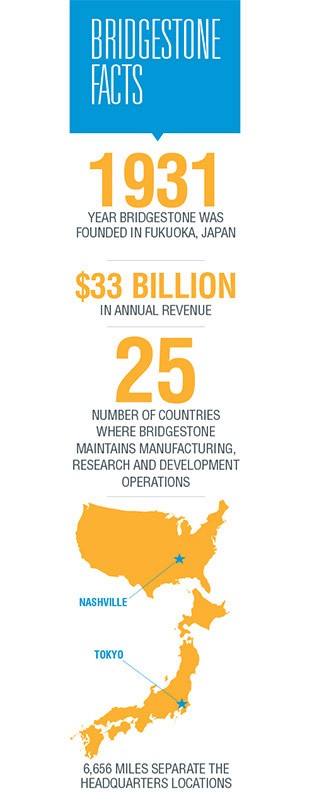Bridgestone: Preventing Cross-Cultural Burnout
When a company gets to be 83 years old, such as the tire manufacturing giant Bridgestone Corp. — with well over $33 billion in annual revenue — it can get set in its ways.
And when a company has manufacturing, research, and development operations in 25 countries, as is the case with Bridgestone, problems such as poor internal communications and cross-cultural misunderstandings can become roadblocks to the company’s success.
Such was the state of affairs in June 2013, when Steve Shelton was promoted to the newly created position of senior vice president, Technology, Manufacturing and Procurement at Bridgestone Americas Tire Operations.
Between 2010 and 2013, Shelton had run what is now called the Bridgestone Americas Technical Center for Research and Technology in Akron, Ohio. The Center, a key research and development shop for the company, simply wasn’t on the same page as the Bridgestone Americas headquarters it reported to in Nashville, Tenn.
“The business side of the house didn’t think we were responsive to their needs,” Shelton says. “Geographically, we were in different places. As an R&D group, we weren’t as responsive as we could have been,” says Shelton, a 30-year veteran of the tire industry who has held 14 different jobs at Bridgestone during his 21-year tenure with the company.
The “us vs. them” mentality that existed in the Akron facility was apparent to outsiders as well.
“One of the things they were convinced of was that nobody really understood their business. Nashville and Japan didn’t,” says Bruce Zimmer, a partner and consultant at Insigniam, which Bridgestone engaged in 2013 to help. “That perspective and belief resulted in them not being proactive in critical areas.”
In fairness to the Akron folks, they simply had a tangled web of people to answer to and had been boxed into focusing on execution, Zimmer says.
“They had a complexity of relationships to manage, very often with conflicting messages and priorities,” Zimmer says. Indeed, the Americas unit of Bridgestone “needed an American identity, rather than just a top-down structure from Japan.”
As de rigueur in Japanese companies, the American managers and executives who were in place had been judged by their ability to make the proverbial trains run on time and not on dealing with the bigger picture.
“They had been trained in executing what had been given to them, instead of thinking about what was needed for success tomorrow,” Zimmer says.
HYDROPLANING INTO CULTURAL ISSUES
It’s easy enough for differences to arise between working groups in different cities, such as in Akron and Nashville. It’s even easier to have that happen in a company like Bridgestone, whose global headquarters is half a world away in Tokyo.
A major reason why cross-cultural differences can arise in this scenario is that Japanese society typically places a greater emphasis on harmony and consensus than does America, according to Dr. R. Ray Gehani, an associate professor at the University of Akron whose titles include Founding Director of Graduate Programs in Technology Management and Innovation.
“What I’ve found is that, cross-culturally speaking, the Japanese are highly civilized and highly conforming,” says Gehani, who has worked in that country and speaks fluent Japanese.
Most new college graduates in Japan “end up conforming to either what their bosses say they want or what they think their bosses want,” he adds.
While Japanese values such as harmony and consensus-building work well on many fronts, they “can act as brakes to radical innovation,” Gehani says.
Indeed, the ability to bring innovation and positive change in a business is a big factor in determining which companies remain at or near the top of the Fortune 500 list over time, according to Dr. Derrick D’Souza, professor of management at the University of North Texas, College of Business.
Firms that fall out of the top slots of that ranking can experience everything from inept management and rigid cultures to organizational complexities, D’Souza says. Winners like Wal-Mart and ExxonMobil, on the other hand, “change constantly,” he says.
“It’s the ability to change — and change in a way that allows them to compete differently,” he says.

NAVIGATING THE CHICANES
 When Shelton first took over the job of running the Akron R&D facility in 2010, he not only had to deal with the cultural dynamics and regional tensions he encountered, but also a series of ancillary issues that needed solving.
When Shelton first took over the job of running the Akron R&D facility in 2010, he not only had to deal with the cultural dynamics and regional tensions he encountered, but also a series of ancillary issues that needed solving.
One of the immediate issues was with Bridgestone’s involvement with the Indy Racing League. The league, an American-based sanctioning body for championship open-wheel racing, at the time oversaw four racing series: the premier IndyCar Series and three developmental series, including Indy Lights, the Pro Mazda Championship, and the U.S. F2000 National Championship. “It was too expensive for the value we were getting,” Shelton says. But keeping that relationship was important to the company, the brand, and to the employees.
This management realignment came on the heels of an 18 percent staff reduction. That cost cutting, Shelton says, allowed for the rescue of Bridgestone’s participation in the Indy Racing League, and “that got us credibility with the team in Akron,” he adds.
Shelton also realized that the gaps in collaboration were aggravated by a lack of understanding between colleagues of each manager’s job function. To help stimulate greater adhesion within the Bridgestone organization, Shelton rotated 70 percent of that group to different roles.
“There’s nothing like walking in the shoes of another person’s job,” he says.
To further develop his managers to acquire a broader perspective, Shelton had Bridgestone participate in a program called “Leadership Akron.” The initiative involved having a Bridgestone employee visit six companies in the Northeast Ohio area to see how things could be done differently, Shelton says.
“With all of that, the executive team developed the view that if we’d done such a good job with the R&D group, we could roll the manufacturing and procurement arms together and get synergies, and then take further steps,” Shelton says. “That’s the purpose of what we’re doing now.”
GOING FOR ANOTHER LAP
Still, there was a less than perfect harmony between the Akron group, the manufacturing arm, and the procurement unit. So Shelton did what he has done so many times before: He took a different job to get a new view.
“I became a procurement guy for four months,” he says. “I had no experience in that. I wanted to see what we were doing.”
And, not surprisingly, he began making changes. For instance, Shelton began buying forward commodities to take advantage of inexpensive prices. More importantly, Shelton began making the procurement group more responsive to the needs of the other Bridgestone units it served.
“We’d been getting a lot of complaints from our Latin American business group about not helping them with their procurement,” Shelton says. After our changes, “We pounded stuff for them in a fashion they’d never seen before. We took those who had been our biggest detractors and made them our promoters.”
Finally, Shelton hired a top-notch procurement expert to take his place in that group.
The end result: “We’ve made dramatic savings in procurement,” Shelton says.
On another front, Bridgestone officials from Akron began meeting with the folks they worked with in Nashville.
“A lot of them got to see that embedded assumptions didn’t have anything to do with the reality today,” Zimmer says. “They started to repair relationships that, in the normal course of events, were damaged. And they started to take responsibility for their role in the disconnect, rather than blaming the other group.”
As a result, Akron and Nashville are getting along much better. “There’s now an environment where things work a whole heck of a lot better and great things are getting done,” Zimmer says.
THE NEXT MILE
Presently, a significant focus for Shelton is on Bridgestone’s manufacturing. “It’s world class,” he says. “But world class today probably isn’t good enough for tomorrow.”
One of the broader Bridgestone goals is to reduce the time it takes to make a tire — from compound to finished product — from 24 to 12 months, according to Zimmer.
While that process is still underway, ratings firms like J.D. Power have recognized Bridgestone quality in all four categories in which the company competes.
Going forward, Bridgestone will become more focused on who the decision maker is for buying its tires, be that for passenger cars, buses, or tractor-trailers, Shelton says.
“We need to better understand what they want,” he says. “We want to be the brand of choice for the decision makers, and our chief marketing officer is doing a lot of work to ensure we’re defining what those parameters are.”
The tire business is competitive, which means Bridgestone lacks the luxury of resting on its laurels. “We’re in the durable goods business,” Shelton says. “We have to be sharp in everything we do.”

